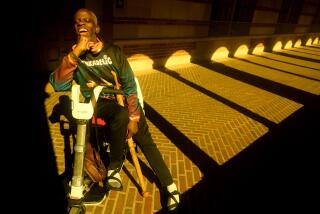Being disabled doesn’t have to mean the end of artistic creativity, it just makes it more challenging for students in a special class in Lakewood.
- Share via
Barbara Davenport always liked working with her hands. She worked years ago as a cosmetologist, and owned a wig and beauty shop. “I couldn’t read, write or spell, but boy . . . I sure could use my hands,” she said.
She speaks in past tense because an automobile accident 13 years ago severed her spine, leaving her a quadriplegic and ending her career.
Davenport, who was in her early 30s at the time, thought her artistic talents also had been severed. But Oil Painting for the Physically Challenged, a monthly art class in Lakewood offered to the disabled, has enabled her to paint again.
“I have been painting for three or four years. I love it, I just love it,” she said, her green eyes sparkling with enthusiasm.
As many as six regular students attend the three-hour class, which meets the second Monday of each month at 1 p.m. in the A-frame building at Maywood Park in Lakewood. Most are paraplegics and quadriplegics who hold the paintbrushes in their mouths when they paint.
“I am able to create and be artistically creative,” Davenport said. “Losing my hands just cut down my creativity a little.”
The class was founded four years ago by Lakewood resident Bernita Wallar, an occupational therapist in private practice. For Wallar, witnessing Davenport’s accomplishments is proof that “it can be done if you have the desire.” But the painting process is time-consuming.
A foot-high pole, holding a tray with an assortment of brushes, is attached to the wheelchair, the brushes at mouth level. Taped to every brush is a stick with a rubberized grip at one end that is guided by the tongue. A specially designed easel, which can hold canvasses of various sizes, is positioned on top of the wheelchair armrest in front of the painter. The artists use oil paint because it does not dry as quickly nor run as readily as watercolor paints.
At first, artists often have sore muscles after continuously using jaw and neck muscles to paint. But the completed work is worth the effort, Davenport said.
“I had never drawn an animal before in my life,” said Davenport. “Here, I did it. I never did a still life. Here, I did daisies. It is such a great opportunity.”
Her biggest challenge was painting a chipmunk’s fur to resemble the full, bushy textured appearance of the real animal. It took a year to complete. “I was so sick of it,” she said with a sigh.
The participants are assisted by volunteers, mostly members of the Lakewood Artist Guild, an organization of Southeast-area artists that also donates the art supplies. Wallar said more volunteers are needed, and art experience is not required.
Wallar was encouraged to set up the program by Jean Cook, a quadriplegic who had begun painting in 1964. They met a few years ago at an Artist Guild meeting.
“I lived in a rest home for 15 years. It (art) filled a lot of my hours,” said Cook, who contracted polio as a child. “A lot of people who are disabled don’t do anything. They just sit around. . . . When they see that I can do it, anyone can.”
Another participant, Barbara Blake, paints by hand, but her movements have been restricted by cerebral palsy.
At a recent session, Blake was adding a few trees to finish a mountain scene. Billie Greer, a volunteer, gently held onto Blake’s brush and attempted to guide it toward the proper spot, but Blake’s hands and arms involuntarily resisted--jerking and straining in the opposite direction.
“One, two, three, four, five . . .” Blake counted while resting before trying again. The attempt was successful, and her pride was evident.
Blake and her husband, Robert, run a computer graphic greeting card business at home. She attends Oil Painting for the Physically Challenged when her schedule permits. Adhered to the back of her wheelchair is a sticker that reads: “Acting crazy is the only thing that keeps me sane.”
Her volunteer helper, Greer, also was encouraged by Blake’s successful attempt to finish the painting.
“Coming here is very rewarding,” Greer said. “I’m the one who goes home satisfied.”






